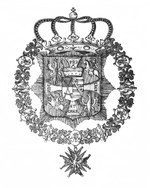Order of the White Eagle (Poland)
It was officially instituted on 1 November 1705 by Augustus II the Strong, King of Poland and Elector of Saxony, and bestowed on eight of his closest diplomatic and political supporters.
The Order of the White Eagle is attached to an azure sash slung over the left shoulder to the right side.
The badge of the Order of the White Eagle was originally a red enamel oval gold medal with an image of the Polish white eagle on its front side, and the royal cypher of Augustus II the Strong over crossed swords on the obverse, worn on a light blue ribbon.
The Order of the White Eagle officially became Poland's highest decoration by act of Parliament of 4 February 1921, and the insignia was redesigned.
After 1948, when the Polish People's Republic came into existence, the Order of the White Eagle was no longer awarded, but it was never officially abolished.
In the centre of the cross was a white enamelled eagle in high relief with spread wings and facing left and with a diamond set royal crown on its head.
The reverse side of this Maltese cross was enamelled white with red borders and had at its center an oval gold medallion with the founder's crowned royal cypher above two crossed swords taken from his arms as the Arch-Marshall of the Holy Roman Empire.The star of the order consisted of an eight-pointed gold star with straight rays which bore a red-bordered white enamelled cross pattée with golden rays between the arms and with a golden rosette at its centre.
The arms of this cross pattée bore the motto "Pro Fide, Lege et Rege" (For Faith, Law and the King) in golden letters.
A white enamel crowned eagle with spread wings, facing left (the coat-of-arms of Poland) was superimposed on the cross.
A white enamel crowned eagle with spread wings, facing left (the coat-of-arms of Poland) is superimposed on the cross.




